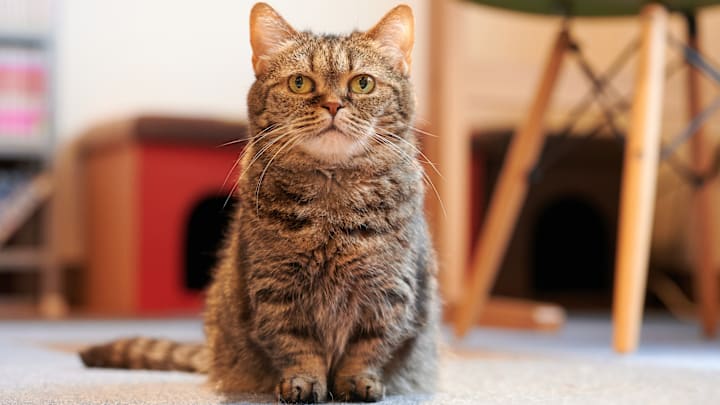With its short little legs and low-slung torso, some people view the munchkin cat as the feline version of a dachshund. Here are seven facts you might not have known about these adorable, stubby-limbed pets.
1. The munchkin breed arose from a genetic mutation.
Like many unusual cat types (including the Cornish rex and the Manx, to name a few), the munchkin breed arose from a spontaneous genetic mutation. The munchkin’s short legs are caused by an autosomal dominant gene, which causes the long bones in a cat’s legs to grow shorter. A cat only needs one copy of the gene to inherit short legs and to pass the trait along to its kittens.
One warning to breeders: The munchkin gene is sometimes referred to as the “lethal” gene because a munchkin cat embryo that receives one of these genes from each parent won’t survive. That’s why breeders don’t mate two short-legged munchkin cats together. Cats born with long legs can carry the munchkin gene, and they’re often mated with each other, or a short-legged munchkin cat, to produce a litter of healthy, stubby-limbed kittens.
2. Munchkin cats come in all kinds of shades, patterns, and colors.

The munchkin’s most distinguishing feature is its legs, which are bow-legged and typically half as long as a regular cat’s limbs. Their front legs are also usually somewhat shorter than their hind legs. Aside from its stubby appendages, the Munchkin looks and acts exactly like a normal, medium-sized feline, and comes in a variety of patterns, colors, and fur lengths.
3. The first American munchkin was a pregnant stray named Blackberry.
Throughout the 20th century, various individuals documented sightings of short-legged feral cats in Great Britain, Russia, and New England. But it wasn’t until the 1980s that people officially began breeding the “kangaroo cat,” which some people called the kitty because its forelegs were shorter than its hind legs, and because some munchkins are known to perch up on their back legs, likely because they are somewhat longer.
The modern-day American munchkin cat is descended from a short-legged pregnant stray, rescued in Rayville, Louisiana, in the early 1980s by a music teacher named Sandra Hochenedel. The cat, whom Hochenedel named Blackberry, birthed similar-looking kittens, and Hochenedel gave one of them to her friend, Kay LaFrance. Because LaFrance let the cat, named Toulouse, roam around outside, her neighborhood was soon filled with short-legged cats.
Hochenedel and LaFrance believed they had a new breed on their hands. In 1990, the two connected with Solveig Pflueger, a geneticist, cat show judge, and former chairperson of the International Cat Association’s (TICA) genetics committee. Pflueger and other experts examined the cats to evaluate the inheritance and expression of their short-legged trait.
The geneticists were worried that the munchkin would have problems with its spine, similar to short-legged dog breeds. They didn’t find any deformities in the cats’ joints or backbones, but, as the breed was so new, some critics didn’t believe that these studies were definitive at the time.
4. It’s unclear how the munchkin cat got its name.

The munchkin cat is presumably named after The Wizard of Oz’s munchkins, but there are two conflicting tales as to how they received the moniker. According to one account, LaFrance gave Pflueger a few of the short-limbed cats, and one of them turned out to be pregnant. Pflueger’s daughter named one of them Mushroom the Munchkin, and voilà, a breed was born.
But another story states that Hochenedel’s short-legged kittens were asked to appear on Good Morning America. The show called her and asked the name of the breed, and Hochenedel quickly chose “munchkin” in honor of the classic film and novel.
5. The munchkin cat is a controversial breed.
In 1991, the munchkin cat was formally introduced to the public via a nationally televised cat show, sponsored by TICA and hosted at Madison Square Garden. By 1995, the munchkin was proposed as an official breed, and was accepted into TICA’s New Breed development program.
The munchkin wasn’t met with outstretched arms, but rather, with unsheathed claws. Some members of the public were horrified over the cat’s physical shape, and one of TICA’s judges even resigned, comparing the breed to “a dwarf” and claiming to be “absolutely horrified” by them.
Today, many people argue that breeding the munchkin is unethical because it perpetuates physical deformities. Experts say that munchkins are fine, health-wise. However, due to the controversy, the Cat Fanciers Association (CFA) and the American Cat Fanciers Association (ACFA) won’t recognize the munchkin, and PETA has spoken out about the breed as well.
6. Munchkins can have health problems.

Aside from their slightly funny walk (and a difficulty jumping onto high surfaces), munchkins are considered to be a relatively healthy breed. Typically, they live from around 12 to 15 years. Some kittens do, however, suffer from lordosis—a condition in which the spinal muscles grow too short, making the spine sink down into the cat’s body. In worst-case scenarios, this condition can be fatal.
Munchkins are also sometimes afflicted by funnel chest, also known as pectus excavatum, a deformity that causes the cat’s breast bone to sink inwards. But because other cat breeds are afflicted by lordosis and pectus excavatum, many munchkin breeders (and some researchers) argue that neither condition is specific to just these short-legged kitties.
7. A munchkin is the world’s shortest living cat.
In 2013, Guinness World Records named Lilieput, a tortoiseshell munchkin cat from Napa, California, the world’s shortest living cat. The diminutive kitty stands a mere 5.25 inches tall from the bottoms of her paws to the top of her shoulders.
A version of this article was originally published in 2016 and has been updated for 2023.
